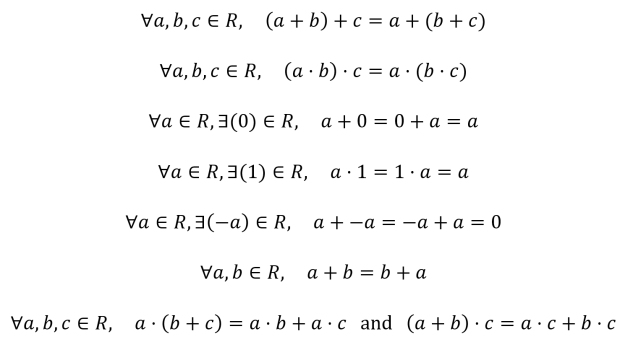Binary Operations
- Definition: a binary operation is an operation performed between any pair of elements from a set S that maps into the same set S.
![]()
- The mapping must be defined for every pair of elements in S and uniquely assign any pair of elements in S to another element in S. (This does not exclude the elements operated upon).
- Addition on the set of real numbers is an example of a binary operation since adding any two real numbers will give another real number. Note that the “upside-down A” symbol denotes “for all.”
![]()
- Addition on the set of complex numbers as well as addition on the set of integers are binary operations.
- Matrix addition on the set of all matrices with real entries is not a binary operation since matrix addition is undefined for matrices with different numbers of rows or columns.
- However, matrix addition on the set of all 2×2 matrices with real entries is a binary operation since adding any given pair of 2×2 matrices will generate another 2×2 matrix. The same holds for the set of all 2×2 matrices with complex entries.
- Subtraction on the set of natural numbers (1,2,3,4…) is not a binary operation because some results will fall outside of the natural numbers (for instance, negative values).
![]()
- Binary operations can take more exotic forms. Any operation that fits the definition of a binary operation is a binary operation.
Groups
- A group G is an algebraic structure consisting of a finite or infinite set and a binary operation which acts between any pair of the elements in that set. Groups have the following properties.
- Closure: given that a and b are in G, the group operation generates a result c that is also in G. (Note that all binary operations are defined to have closure regardless of whether they belong to a group).
![]()
- Associativity: the group operation is associative.
![]()
- Identity: there is an identity element e such that the relations below hold.
![]()
- Inverse: there must be an inverse of each element.
![]()
- As such, groups are sets equipped with a generalized addition operation.
- To prove that G is a group, simply demonstrate in general terms (by manipulating symbols rather than specific values) that the properties above hold for all elements of G. Note that the identity element e may need to be algebraically solved for as a separate exercise from the proof itself.
- Abelian groups are groups for which the group operation is commutative on the set G.
![]()
- Some group-like structures that commonly occur in abstract algebra are given along with their properties in the table below.

Rings
- Many number systems (i.e. the set of real numbers, the set of polynomials, etc.) share the binary operations of addition and multiplication.
- Addition is a binary operation with the properties of closure (by definition of a binary operation), associativity, additive identity a+0=0+a=a, additive inverse a+-a=-a+a=0, and commutativity. Addition forms an Abelian group on a set where it is defined.
- Multiplication is a binary operation with the properties of closure (by definition of a binary operation), associativity, multiplicative identity a•1=a, multiplicative inverse a•(1/a)=a, and distributivity of multiplication over addition a(b+c)=a•b+a•c and (a+b)•c=a•c+b•c. Multiplication is commutative on some sets (i.e. the reals), but not others (i.e. real 2×2 matrices). Note that when the set contains 0, multiplication cannot form a group because 0 generally has no multiplicative inverse.
- A ring is a set R equipped with the binary operations of addition and multiplication. Rings have the following properties. Note that the “backwards E” symbol denotes “there exists.” The elements denoted by 1 and 0 are generalized and do not always refer to numbers.

- Some examples of rings include the set of real numbers equipped with addition and multiplication, the set of complex numbers equipped with addition and multiplication, the set of rational numbers equipped with addition and multiplication, the set of polynomials R[x] equipped with addition and multiplication, and the set of square matrices equipped with addition and multiplication. Note that, since rings do not require a multiplicative inverse or commutativity with respect to multiplication, they can be defined on a wider variety of sets than would be possible otherwise. This standard type of ring is also known as a noncommutative ring.
- Commutative rings are rings which have the additional property given below.
![]()
Fields
- Consider a ring R containing an element a ≠ 0 and an element b ≠ 0 The element a is called a zero divisor if either of the formulas below holds.
![]()
- Commutative rings without any zero divisors are called integral domains. Some examples of integral domains include ℝ, ℂ, ℤ, and ℚ.
- Multiplicative cancellation holds for integral domains. Note that R denotes a ring and not the real numbers.
![]()
- Consider a ring R and a nonzero element a ∈ If there also exists an element b ∈ R such that ab = ba = 1, then the elements a and b are multiplicative inverses of each other and are called invertible. Invertible elements of R are also called units of the ring R.
- If all the nonzero elements of an integral domain are invertible, then the integral domain is called a field. As such, fields are sets equipped with a division operation as well as addition and multiplication operations.
Reference: A Gentle Introduction to Abstract Algebra
WONDERFULL
GO AHEAD
LikeLike